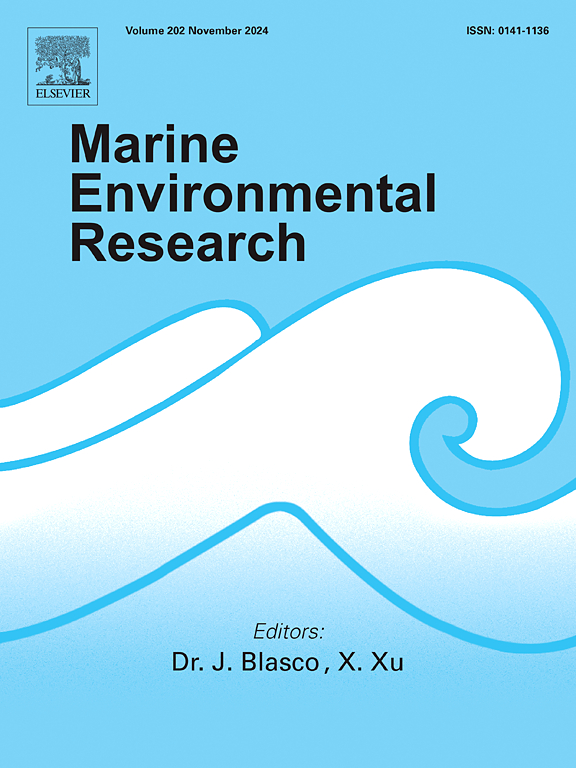陈化微塑料对牡蛎及其排泄物中抗生素抗性基因丰度的影响
IF 3.2
3区 环境科学与生态学
Q2 ENVIRONMENTAL SCIENCES
引用次数: 0
摘要
塑料在全球水产养殖中的广泛使用引起了人们对其环境影响的担忧,特别是由于它们降解成微塑料(MPs)。这些MPs不仅对水生生物和生态系统构成威胁,而且是抗生素抗性基因(ARGs)等新兴污染物的载体。通过促进ARGs在水生环境中的富集和运输,MPs可能加剧抗生素耐药性的传播,特别是在滤食性生物中。MPs对牡蛎中ARGs的潜在影响以及进一步的风险尚未明确阐明。本研究探讨了陈化聚乙烯(PE)和聚对苯二甲酸乙二醇酯(PET) MPs对牡蛎(Magallana angulata) ARGs丰度的影响。我们的研究结果表明,在水产养殖环境中,MPs在老化三个月后显著富集ARGs,并根据聚合物类型有所不同。MPs暴露两周后,牡蛎组织中ARGs的绝对丰度出现波动,tetA (PE MPs暴露)、tetG (PET MPs暴露)和oqxB显著增加,而fexA受到抑制。然而,尽管ARGs是牡蛎组织(不含tetC)的1.16 ~ 5.46 × 109倍,但粪便中的ARGs没有明显的变化趋势。此外,在组织中观察到intI1和sul2/tetG之间以及排泄物中intI1和sul1之间存在显著的正相关,表明ARGs可能通过食物链或排泄物传播。这项研究促进了我们对MPs和ARGs之间复杂相互作用的理解,强调了有效管理策略的必要性,以减轻其生态和公共卫生风险。本文章由计算机程序翻译,如有差异,请以英文原文为准。
Effects of aged microplastics on the abundance of antibiotic resistance genes in oysters and their excreta
The widespread use of plastics in global aquaculture raises concerns about their environmental impact, particularly due to their degradation into microplastics (MPs). These MPs not only pose risks to aquatic organisms and ecosystems but also serve as carriers for emerging pollutants such as antibiotic resistance genes (ARGs). By facilitating the enrichment and transport of ARGs in aquatic environments, MPs may exacerbate the spread of antibiotic resistance, particularly in filter-feeding organisms. The underlying effects of MPs on ARGs in oysters and the further risks have not been clearly elucidated. Here, we explored the effects of aged polyethylene (PE) and polyethylene terephthalate (PET) MPs on ARGs abundance in oysters (Magallana angulata). Our results showed that MPs significantly enriched ARGs after three months of aging in the aquaculture environment with variations depending on polymer type. After two weeks of MPs exposure, the absolute abundance of ARGs in oyster tissues fluctuated, with tetA (PE MPs exposure), tetG (PET MPs exposure), and oqxB significantly increasing, while fexA was suppressed. However, despite being 1.16 to 5.46 × 109 times higher than in oyster tissues (excluding tetC), ARGs in excreta showed no significant trend. Additionally, significant positive correlations were observed between intI1 and sul2/tetG in tissues and between intI1 and sul1 in excreta, suggesting potential ARGs transmission through the food chain or excretion. This study advances our understanding of the complex interactions between MPs and ARGs, underscoring the need for effective management strategies to mitigate their ecological and public health risks.
求助全文
通过发布文献求助,成功后即可免费获取论文全文。
去求助
来源期刊

Marine environmental research
环境科学-毒理学
CiteScore
5.90
自引率
3.00%
发文量
217
审稿时长
46 days
期刊介绍:
Marine Environmental Research publishes original research papers on chemical, physical, and biological interactions in the oceans and coastal waters. The journal serves as a forum for new information on biology, chemistry, and toxicology and syntheses that advance understanding of marine environmental processes.
Submission of multidisciplinary studies is encouraged. Studies that utilize experimental approaches to clarify the roles of anthropogenic and natural causes of changes in marine ecosystems are especially welcome, as are those studies that represent new developments of a theoretical or conceptual aspect of marine science. All papers published in this journal are reviewed by qualified peers prior to acceptance and publication. Examples of topics considered to be appropriate for the journal include, but are not limited to, the following:
– The extent, persistence, and consequences of change and the recovery from such change in natural marine systems
– The biochemical, physiological, and ecological consequences of contaminants to marine organisms and ecosystems
– The biogeochemistry of naturally occurring and anthropogenic substances
– Models that describe and predict the above processes
– Monitoring studies, to the extent that their results provide new information on functional processes
– Methodological papers describing improved quantitative techniques for the marine sciences.
 求助内容:
求助内容: 应助结果提醒方式:
应助结果提醒方式:


